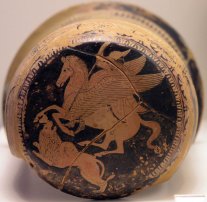
The Melammu ProjectThe Heritage of Mesopotamia and the Ancient Near East |
The Melammu Project
General description
Search string
Browse by topic
Search keyword
Submit entry
About
Open search
Thematic search
Digital Library
Submit item
Ancient texts
Dictionaries
Projects
Varia
Submit link
FAQ Contact us
About
The Newsletter
To Project Information >
Bellerophon and Chimaira (1) |
Printable view |
|
Topics (move over topic to see place in topic list) 02 Religious and ideological symbols and iconographic motifs 04 Religious and philosophical literature and poetry 02 Religious and ideological symbols and iconographic motifs |
Keywords chimaera composite beings |
|
Period 6th century CE Roman Empire |
Channel Christian-Greek philosophers and scholars |
|
Text
Source (list of abbreviations)
Amar Annus
|
Illustrations (click an image to view the full-size version in a new window)
 |
Fig. 1: Bellerophon and Chimaira. Edge of an Attic red-figure epinetron , ca. 425-420 BCE (No 2179, National Archaeological Museum in Athens, Greece). |